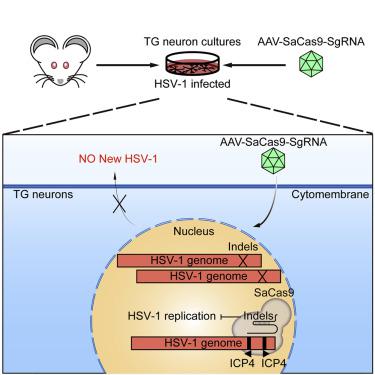Molecular Therapy - Methods & Clinical Development ( IF 4.6 ) Pub Date : 2020-05-22 , DOI: 10.1016/j.omtm.2020.05.011 Yuxi Chen 1, 2 , Shengyao Zhi 2 , Puping Liang 2 , Qi Zheng 2 , Mengni Liu 2 , Qi Zhao 2 , Jian Ren 2 , Jun Cui 2 , Junjiu Huang 1, 2, 3 , Yizhi Liu 1 , Zhou Songyang 1, 2

|
Herpes simplex keratitis (HSK) is the most common cause of corneal blindness in developed nations, caused by primary or recurrent herpes simplex virus 1 (HSV-1) infection of the cornea. Latent infection of HSV-1, especially in the trigeminal ganglion (TG), causes recurrence of HSV-1 infection. As antiviral treatment is not effective on latent HSV-1, to test the possibility of inhibiting HSV-1 by SpCas9 (Streptococcus pyogenes Cas9) or SaCas9 (Staphylococcus aureus Cas9), ICP0 and ICP4, two important genes required for HSV-1 replication and reactivation, were chosen as targets. In Vero cells, SpCas9 and SaCas9 targeting ICP0 or ICP4 can effectively inhibit the proliferation of HSV-1 without affecting cell viability. No significant guide RNA (gRNA)-dependent off-targets were observed in the human genome by digenome sequencing and deep sequencing verification. Adeno-associated virus 1 (AAV1)-mediated delivery of SaCas9 inhibits HSV-1 replication by targeting ICP4 in mouse primary TG neuronal cells. SpCas9 and SaCas9 are able to inhibit HSV-1 infection in Vero cells and mouse TG neuronal cultures with high efficiency and good biosafety. AAV1-mediated delivery of SaCas9 shows great potential in treating HSK and inhibiting HSV-1 in TG neurons. Further investigations may be needed to test the inhibition of latent infections, which may result in the development of novel methods for treating viral diseases.
中文翻译:

单个AAV介导的CRISPR-SaCas9通过编辑三叉神经节神经元中的ICP4抑制HSV-1复制。
单纯疱疹性角膜炎(HSK)是发达国家中由角膜的原发性或复发性单纯疱疹病毒1(HSV-1)感染引起的角膜失明的最常见原因。HSV-1的潜在感染,尤其是在三叉神经节(TG)中,会导致HSV-1感染复发。由于抗病毒治疗对潜在的HSV-1无效,因此需要测试通过SpCas9(化脓性链球菌Cas9)或SaCas9(金黄色葡萄球菌Cas9),ICP0和ICP4抑制HSV-1的可能性,这两个基因是HSV-1复制和重新激活,被选为目标。在Vero细胞中,SpCas9和SaCas9靶向ICP0或ICP4可以有效抑制HSV-1的增殖而不影响细胞活力。通过双基因组测序和深度测序验证,在人类基因组中未观察到明显的依赖引导RNA(gRNA)的脱靶现象。腺相关病毒1(AAV1)介导的SaCas9的传递通过靶向ICP4在小鼠原代TG神经元细胞中抑制HSV-1复制。SpCas9和SaCas9能够高效和良好的生物安全性抑制Vero细胞和小鼠TG神经元培养物中的HSV-1感染。AAV1介导的SaCas9的递送显示出治疗TG神经元中的HSK和抑制HSV-1的巨大潜力。可能需要进一步的研究来测试对潜伏感染的抑制,这可能会导致开发治疗病毒性疾病的新方法。











































 京公网安备 11010802027423号
京公网安备 11010802027423号